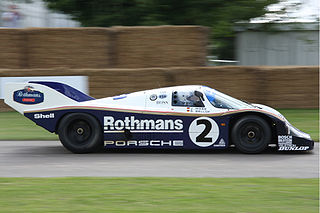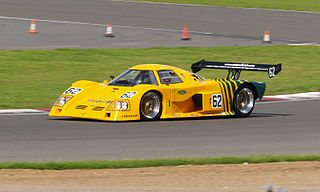
Sports car racing is a form of motorsport road racing which utilises sports cars that have two seats and enclosed wheels. They may be purpose-built prototypes or grand tourers based on road-going models. Sports car racing is one of the main types of circuit auto racing, alongside open-wheel racing, touring car racing and stock car racing. Sports car races are often, though not always, endurance races that are run over particularly long distances or large amounts of time, resulting in a larger emphasis on the reliability and efficiency of the car and its drivers as opposed to outright car performance or driver skills. The FIA World Endurance Championship is an example of one of the best known sports car racing series.

The Porsche 961 was a racing car built by Porsche and based on their 959 sports car. It was intended for Group B sports car racing, complementing the purpose-built 956 and 962C which ran Group C in the World Sports-Prototype Championship. The 961 project was short-lived, running only three races and seeing the construction of only one car. Plans to sell the car to customers were scrapped when the Group B class was canceled.

A Le Mans Prototype (LMP) is a type of sports prototype race car used in various races and championships, including the 24 Hours of Le Mans, FIA World Endurance Championship, IMSA SportsCar Championship, European Le Mans Series, and Asian Le Mans Series. Le Mans Prototypes were created by the Automobile Club de l'Ouest (ACO). The technical requirements for an LMP include bodywork covering all mechanical elements of the car. As of 2023, there are two classes within Le Mans Prototypes, designated LMP2 and LMP3.

The Porsche 956 was a Group C sports-prototype racing car designed by Norbert Singer and built by Porsche in 1982 for the FIA World Sportscar Championship. It was later upgraded to the 956B in 1984. In 1983, driven by Stefan Bellof, this car established a record that would stand for 35 years, lapping the famed 20.832 km (12.93 mi) Nürburgring Nordschleife in 6:11.13 during qualifying for the 1000 km Sports Car race. The record was finally surpassed by Timo Bernhard in a derestricted Porsche 919 Evo on 29 June 2018.

The Porsche 962 is a sports prototype racing car designed and built by Porsche. Created to replace the Porsche 956, 962 was introduced at the end of 1984 and replaced the 956 in the IMSA's GTP class in 1985 due to regulation changes obsoleting the 956. It was also introduced in the World Sportscar Championship's Group C category in 1984. Over its decade-long career, the car in its Group C form won the 24 Hours of Le Mans twice, with a derivative of the car, the Dauer 962 Le Mans, winning a further title in 1994. In total, the 962 scored nineteen total constructor's championships across various series. The 962's successor was the Porsche WSC-95, introduced for the 1996 24 Hours of Le Mans, but did not receive factory backing or support.

The World Sportscar Championship was the world series run for sports car racing by the FIA from 1953 to 1992. The championship evolved from a small collection of the most important sportscar, endurance, and road racing events in Europe and North America with dozens of gentleman drivers at the grid to a professional racing series where the world's largest automakers spent millions of dollars per year.

The 1986 24 Hours of Le Mans was the 54th Grand Prix of Endurance as well as the third round of the 1986 World Sports-Prototype Championship. It took place at the Circuit de la Sarthe, France, on 31 May and 1 June 1986. This year saw the return of a full Jaguar works team, to take on the strong Porsche works and customer teams. However, with the fuel regulations relaxed, the turbo-charged cars would be able to use more of their potential power to outrun the normally-aspirated 6-litre Jaguars.
Kremer Racing is a motorsports team based in Cologne, Germany, founded by racing driver Erwin Kremer and his brother Manfred. They have competed internationally with Porsches for nearly all of their existence, and were even one of the factory-backed squads for many years. Besides running Porsches, the team was also known for their tuned Porsche race cars that they both raced and sold to other teams who could not gain the best equipment from the factory.

Joest Racing is a German sports car racing team that was established in 1978 by former Porsche works racer Reinhold Joest. Their headquarters are in Wald-Michelbach, Germany.

Porsche has been successful in many branches of motorsport of which most have been in long-distance races.

The Lancia LC2 was a series of racing cars built by Italian automobile manufacturer Lancia and powered by engines built by their sister company Ferrari. They were part of Lancia's official factory-backed effort in the World Sportscar Championship from 1983 to 1986, although they continued to be used by privateer teams until 1991. They were also the company's first car meeting the FIA's new Group C regulations for sports prototypes.
Richard Hugh Lloyd was a British racing car driver and founder of multiple sports car and touring car teams. He drove in multiple championships himself, including the British Saloon Car Championship and the World Endurance Championship.

The 1984 Sandown 1000 was an endurance motor race staged at the Sandown Raceway in Victoria, Australia on 2 December 1984. It was the eleventh and final round of the 1984 FIA World Endurance Championship and was the first FIA World Championship race to be held in Australia. It was to be the first of a three-year contract to race at Sandown, though the final two years would be cancelled.
Dauer Sportwagen GmbH was a German automotive company founded by former racing driver Jochen Dauer in Nuremberg. Initially founded as Jochen Dauer Racing in 1987, the racing team had several years of participation in the German Supercup and European Interserie championships, as well as occasional runs in the World Sports-Prototype Championship and Camel GT Championships with the Porsche 962. Following the demise of sports prototype racing in the early 1990s, Dauer Racing GmbH was created to begin limited production of road cars, including a road-legal version of the 962, known as the Dauer 962 Le Mans, which later went on to win the 1994 24 Hours of Le Mans. Once changing to Dauer Sportwagen, the company sold a continuation of the Bugatti EB110. The company went bankrupt in 2008 and parts for the EB110 were transferred to Toscana-Motors GmbH.

The 1986 ADAC Kouros 1000 km Nürburgring was the seventh round of the 1986 World Sports-Prototype Championship. It took place at the Nürburgring, West Germany on August 24, 1986.

The 1985 1000 km Spa was the seventh round of the 1985 World Endurance Championship. It took place at the Circuit de Spa-Francorchamps, Belgium on September 1, 1985. In the first half of the race the two leading drivers collided, which resulted in the death of defending Drivers Champion Stefan Bellof. The race organisers ended the race early, thus allowing the Martini Racing Lancia of drivers Mauro Baldi, Bob Wollek, and Riccardo Patrese to win their only victory of the year. It was also the last victory scored by the Lancia LC2.

The Ford C100 is a sports racing car, initially built and run as a Group 6 car, but later as a Group C car. The C100 was built by Ford in 1981, and initially featured a 4-litre Cosworth DFL V8 engine, which was replaced by a 3.3-litre version of the same engine in 1983, after the car had passed to private hands. Five cars are known to have been built. Although the cars were often very quick in qualifying, reliability problems plagued them, and restricted their successes to two Deutsche Rennsport Meisterschaft victories in 1982, and a single Thundersports victory in 1983.

The 2014 FIA World Endurance Championship season was the third season of the FIA World Endurance Championship auto racing series, co-organized by the Fédération Internationale de l'Automobile (FIA) and the Automobile Club de l'Ouest (ACO). The series was open to Le Mans Prototypes and grand tourer-style racing cars from four ACO categories. World Championship titles were awarded for Le Mans Prototypes drivers and for LMP1 manufacturers, and several World Endurance Cups and Endurance Trophies were also awarded. The eight race series began in April at the Silverstone Circuit and concluded in November at the Autódromo José Carlos Pace.
Chamberlain Engineering was an automotive engine builder turned auto racing team founded by racing driver Hugh Chamberlain in 1972. The team moved through the British national sports car championships before becoming a competitor in the World Sportscar Championship, eventually winning world titles in 1989 and 1992. Chamberlain went on to develop sports cars for Jaguar and Lotus in the 1990s before becoming a customer of the Chrysler Viper GTS-R program in the FIA GT Championship; the team later led MG's return to Le Mans in 2001. Chamberlain later merged with Gareth Evans to form Chamberlain-Synergy Motorsport to campaign TVRs in 2004 before moving to the European Le Mans Series where they won another championship in 2005. Chamberlain-Synergy left active motorsports in 2008, although Hugh Chamberlain continues to work as a manager and consultant with other teams in sports car racing.

The Porsche 963 is an LMDh sports prototype racing car designed by Porsche and built by Multimatic, to compete in the Hypercar and GTP classes in the FIA World Endurance Championship and IMSA SportsCar Championship, respectively. The 963 name draws inspiration from the Porsche 956 and Porsche 962 that raced in the 1980s, which also competed in American and European racing series. The car was revealed at the 2022 Goodwood Festival of Speed, with a traditional red, white, and black livery.





















